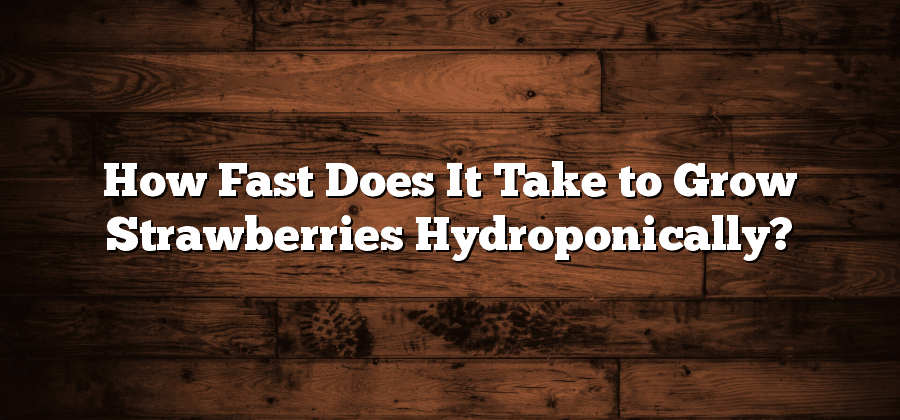The Advantages of Hydroponic Strawberry Cultivation
Hydroponic strawberry cultivation offers a range of distinct advantages for farmers and enthusiasts alike. By eliminating the need for soil, this innovative growing method allows for greater control over the plant’s environment. This means that factors such as temperature, water supply, and nutrient intake can be precisely tailored to suit the specific needs of strawberries. As a result, growers can cultivate strawberries in regions where soil conditions may not be suitable, or in urban areas with limited space.
Furthermore, hydroponic strawberry cultivation promotes faster growth and higher yields compared to traditional soil-based methods. By providing the plants with an optimized nutrient solution, growers can ensure that the strawberries receive all the essential nutrients they require for rapid development. Additionally, with the absence of soil-borne pests and diseases, hydroponic strawberries have a reduced risk of infestation, leading to healthier plants and superior quality fruits. Overall, the advantages of hydroponic strawberry cultivation make it an attractive option for individuals who seek to grow this delectable fruit in a controlled and efficient manner.
Selecting the Ideal Hydroponic System for Strawberries
Hydroponic farming is quickly gaining popularity due to its numerous advantages in terms of efficient space utilization, reduced water consumption, and increased crop yields. When it comes to cultivating strawberries using hydroponics, selecting the ideal hydroponic system is crucial for achieving optimal growth and maximum harvests.
One popular hydroponic system for strawberries is the Nutrient Film Technique (NFT). This system involves a thin film of nutrient-rich water flowing continuously over the plant roots, allowing for efficient nutrient absorption. NFT systems are ideal for strawberries as they provide a constant supply of water and nutrients while ensuring sufficient oxygenation for the roots. However, it is important to monitor the pH and nutrient levels regularly to maintain an ideal growing environment for strawberries in the NFT system.
Another effective hydroponic system for growing strawberries is the Drip Irrigation system. In this system, nutrient-rich water is dripped directly onto the plant’s root zone, facilitating efficient nutrient absorption. Drip irrigation systems are known for their flexibility and suitability for various plant types, including strawberries. Additionally, they allow for precise control over the nutrient delivery, ensuring optimal growth conditions for strawberries. However, it is essential to use a filtration system to prevent clogging of the drip emitters and regularly monitor the pH and nutrient levels to avoid any imbalances.
When selecting the ideal hydroponic system for strawberries, it is crucial to consider factors such as the desired level of automation, available space, budget, and personal preferences. Remember to choose a system that provides easy access for maintenance and monitoring of the plants. By carefully selecting the appropriate hydroponic system, you can ensure the successful cultivation of strawberries, leading to healthy and bountiful harvests.
Essential Nutrients for Accelerated Strawberry Growth
Strawberries are highly nutritious and sought after for their sweet and tangy flavor. To achieve accelerated growth and maximize the yield of hydroponic strawberry cultivation, it is crucial to provide the plants with the essential nutrients they require. These nutrients play a crucial role in various physiological processes, boosting overall plant health and enhancing fruit production.
One of the most essential nutrients for strawberries is nitrogen. It is primarily responsible for promoting vigorous leaf and stem growth. Nitrogen aids in the synthesis of proteins and enzymes, which are vital for cellular growth and development. Another critical nutrient is phosphorus. Phosphorus is crucial for the formation and development of strong root systems, promoting nutrient absorption and overall plant vigor. Additionally, phosphorus contributes to the production of ATP (adenosine triphosphate), the energy currency of cells, enabling optimal metabolic functioning.
Another important nutrient for accelerated strawberry growth is potassium. Potassium regulates osmotic balance in plants and aids in the movement of water and nutrients throughout the plant. It also plays a vital role in improving fruit quality, flavor, and shelf life. Additionally, potassium helps the plants withstand environmental stresses such as heat and drought. Furthermore, trace elements like iron, manganese, zinc, and copper are essential for various enzymatic reactions and ensure proper plant development. These micronutrients, though required in small quantities, play a significant role in maintaining plant health and boosting productivity.
The presence of these essential nutrients is indispensable for accelerated strawberry growth in a hydroponic system. By providing the right balance of nutrients, growers can ensure that the hydroponic strawberries thrive and produce high-quality, delicious fruits. In the next section, we will discuss the importance of providing optimal lighting conditions for hydroponic strawberries, further enhancing their growth potential.
Providing Optimal Lighting Conditions for Hydroponic Strawberries
Lighting is a critical factor in the success of hydroponic strawberry cultivation. Since hydroponic systems lack natural sunlight, growers must provide artificial lighting to ensure optimal growth and fruit production. The right lighting conditions can promote photosynthesis, stimulate flowering, and even enhance the taste and nutritional quality of strawberries.
When selecting lighting for hydroponic strawberries, it is important to consider the spectrum of light emitted. **Blue light** stimulates vegetative growth and is particularly beneficial during the early stages of plant development. On the other hand, **red light** encourages flowering and fruiting, making it essential during the later stages. Some growers opt for using full-spectrum LED lights, which provide a balanced combination of blue, red, and other wavelengths to meet the plants’ needs throughout their growth cycle. Additionally, the intensity and duration of light exposure also play a crucial role. To mimic natural conditions, it is recommended to provide a minimum of 12-16 hours of light per day, keeping in mind that excessive exposure can be detrimental.






